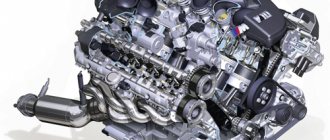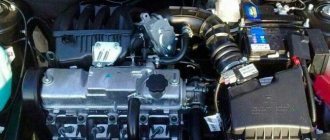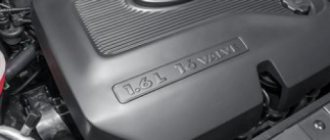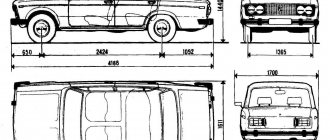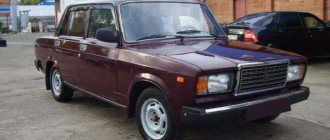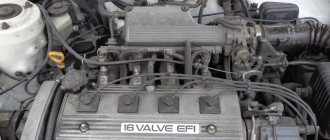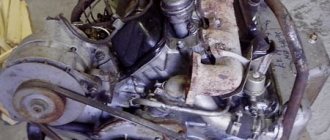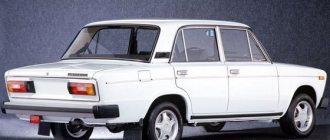The great invention of the 17th century is still the basis of any modern car. Aren't the driving characteristics of an iron horse, fuel consumption and power the main source of pride for a motorist? And in this regard, the 16 valve engine of the VAZ 2110 pleases with truly excellent technical indicators. However, everywhere there is a “but” that is worth mentioning.
Despite the fact that the 16-valve system is today the most popular not only for VAZ 2110-2112 cars, but also for the automotive industry in general, everything has its downside. Ignorance of the operating features of internal combustion engines can cause unreasonably expensive repairs and unexpected failure of the machine at the most inopportune moment. It’s really worth talking about how to avoid such an unpleasant situation.
Engine VAZ 2110 16 valve
Or maybe you’re just wondering what the rhythmic growl under the hood of your VAZ 2110 (2112) can tell you. For many people, buying a car is a significant investment for the rest of their lives. The ability to understand your iron friend is worth a lot, because you have to travel considerable distances with him on your life’s journey. And in life, as you know, anything can happen. And everyone needs to be prepared for this.
Of course, it is difficult to cover such a broad topic in one article. Therefore, it is very important to convey to motorists the most key details regarding the operation of their specific engine and the main differences between the internal combustion engines for VAZ-2110 (2112) cars. If you want to know really useful things regarding the operation of your car, then don’t stop reading, it will only get more interesting.
Advantages of a sixteen-valve engine
We have already said that the internal combustion engines of the VAZ-2110 (2112) family discussed in the article are distinguished by greater power, lower fuel consumption, and also high technical characteristics, unlike the V8s. It's time to find out what design features make the VAZ 2112 16 valve engine such an attractive choice for motorists.
Let’s immediately make a reservation about exactly what “advantages” will be discussed in this section of the article:
- fuel economy;
- higher power;
- detonation resistance;
- advanced cooling system;
- simple tuning due to the separation of the intake and exhaust tracts.
It is the separation between the intake and exhaust tracts in the design of the VAZ-21120 and 21124 engines that makes it possible to achieve quite noticeable fuel savings. Thus, the supply of fuel and the intake of exhaust gases is carried out by a separate spaced valve system, due to which there is no unwanted mixing of fuel and combustion products. It is also obvious that this increases the efficiency of the engine and its power.
Sixteen-valve VAZ 2110 engine
The innovations did not ignore the combustion chamber, as well as the structure of the cylinder block. Their design is slightly modified in such a way that the risk of detonation of the fuel mixture is minimized. This is truly a significant advantage, because the quality of gasoline in our gas stations leaves much to be desired. Accordingly, this kind of internal combustion engine design remains a guarantee of its long service life.
The operation of the cooling system of such devices is also pleasing with high stability. This is the most important factor ensuring long engine operation and reliability during its operation. Effective heat removal allows the internal combustion engine to operate at a given temperature, preventing premature wear. Are the benefits of 16 valves significant enough for you? But that is not all.
Engine VAZ 2110 1.6 l. 16-valve injector
- Working volume - 1596 cm3
- Number of cylinders - 4
- Number of valves - 16
- Cylinder diameter - 82 mm
- Piston stroke - 75.6 mm
- Power 16 cl. - 89 hp (65.5 kW) at 5600 rpm
- Torque 16 cl. — 131 Nm at 3800 rpm
- Compression ratio - 10.3
- Power system - distributed injection
- Acceleration to 100 km/h - 12 seconds
- Maximum speed - 185 kilometers per hour
- Average fuel consumption - 7.2 liters
It is worth noting that today Avtovaz mainly produces 1.6-liter engines, and 1.5-liter units are no longer installed on Lada models, but they are quite common on “tens”.
Tuning of the internal combustion engine cylinder block, conversion of the 8 valve VAZ-2110 (2112) engine to 16 valve.
Tell me, after reading all the above-mentioned information, are you not inspired by the idea of having a car with 16 internal combustion engine valves? In this case, you will be pleased to know that this kind of modernization is allowed. Of course, this process is thorough and cannot be completed without careful preparation. But the result will really justify itself. If you have any doubts, just read the next few paragraphs of the text.
Without going into technical details, the essence of tuning is to replace the cylinder head with a new one. Of course, now you will have two camshafts, and you will also have to rack your brains over the fastening system, because the diameters of the holes in the 16 valve head do not correspond to those on the 8 valve head.
The mounting holes of the block head should be drilled, increasing the diameter from 10 to 12 millimeters.
You can do this yourself, but it is better to contact a specialized workshop. For this kind of work they should not charge more than 3-4 hundred rubles. It should also be taken into account that the standard mounting bolt for the 16-valve cylinder block is slightly smaller than that for the “eight” and must be shortened accordingly.
It is better to study in advance what a 16-valve engine is like on a VAZ 2110 and then you will certainly be able to carry out this kind of tuning yourself. It will be necessary to change the timing belt, pump pump, rollers, wiring, spark plugs, connecting rod mechanism and other structural elements due to the peculiarity of the cylinder head. The head is assembled separately before installation on the engine. After completing the work, it is also advisable to use specialized services for setting up and calibrating the operation of the internal combustion engine.
Engine VAZ 2110 1.5 l. 16-valve injector
- Working volume - 1499 cm3
- Number of cylinders - 4
- Number of valves - 16
- Cylinder diameter - 82 mm
- Piston stroke - 71 mm
- Power - 93 hp (68 kW) at 5600 rpm
- Torque - 128 Nm at 3800 rpm
- Compression ratio - 10.5
- Power system - distributed injection
- Acceleration to 100 km/h - 12.5 seconds
- Maximum speed - 180 kilometers per hour
- Average fuel consumption - 7.2 liters
Model 21103 - “new” line 110
The VAZ 211103 model is the third modification of the 110 line. The oldest “brother” of this model is the first version of the Lada 2110 with an 8-valve carburetor engine, launched into production in 1996. Then, in the same 1996, the country saw the second modification of the VAZ 21102, which was designed to introduce injection engines into the line. But the number of valves still remained 8. And in 1997, the VAZ 21103 car with a sixteen-valve injection power unit was released.
In addition to the engine, version 21103 has the following innovations compared to its predecessors:
- ABS system;
- air conditioner;
- power steering.
Galvanized body, ventilated brakes, new gasoline vapor recovery system and air-conditioned interior. All these opportunities are real know-how for the Russian automotive industry in 1997. Additional trim levels also included power windows, metallic paint, 14-inch alloy wheels, and even an on-board computer.
VAZ-2110 owner reviews
With VAZ-2111 1.5 8 valve engine
- Igor, Kyiv. The car is just right for a family. I bought it in 2008, made in Ukraine. The build quality is the same, quite satisfactory for the money. Now the mileage is 112 thousand, there were breakdowns with the fuel pump and in the gearbox. Everything has already been replaced, and it was relatively inexpensive. In the city, the car consumes 9 liters, with a manual transmission and a 1.5-liter engine.
- Tatyana, Dnepropetrovsk. The car is quite comfortable and dynamic, with a 1.5-liter engine. It seems that under the hood the unit is much more powerful. Excellent smoothness and directional stability. Behavior on the road is all good, but reliability has let us down. I often take my car to a service center; at least the parts are inexpensive. Fuel consumption is 10 liters per hundred.
- Yaroslav, Moscow. I have a 110th Lada with a 1.5-liter 8-valve engine, in the city it consumes up to 10 liters, and on the highway - 8-9 liters. If you don't pick too much, you won't find any equal to this car.
- Anatoly, Lutsk region. I bought a VAZ-2110 in 1999, with an 8-valve 1.5 engine. The engine pleased me with its vigorous acceleration and efficiency. The unit is quite noisy, but this is typical for a budget car. The car behaves well at high speed, especially on a straight line - directional stability is excellent. This is one of the main advantages of the ten, and I also praise it for its more or less spacious interior for five and good finishing materials. Fuel consumption with a one and a half liter engine is 9 liters of gasoline in the city.
- Boris, Sverdlovsk. I'm happy with the car, it's a worthwhile workhorse. Ideal for taxi work. I repainted it yellow and am now getting clients. Now the mileage is 120 thousand km, I service it myself. I always have a set of pelvic guides in the trunk, everything is as it should be. The only negative in the design is the thick stern, perhaps even too thick. Otherwise, I will praise the car for its brutal and austere appearance in the style of the 1980s.
- Oleg, Vologda region. I have a ten since 2005, I use it every day. It rides comfortably and accelerates nicely. Under the hood there is a 1.5-liter 8-valve engine, with which gasoline consumption does not exceed 10 liters per hundred.
- Larisa, Perm. I have a lot in common with this car, first my father used it, then my brother. Then I decided to buy a brand new Volkswagen and sell the ten. And then I showed up. In short, the car became mine, and I will not give it to anyone. I was used to ten, I didn’t even expect it. A very comfortable car. Just right for the city. As for breakdowns, let the service deal with them. I just want the car to drive. Fuel consumption is 10 liters, with a 1.5 petrol engine.
- Nikolay, Donetsk. Lada 110 is a universal car for every day. Equipped with a 1.5-liter engine, although only 8 valves. Fuel consumption in the city is 10 liters. I liked the car, but I advise those who have not driven one not to listen.
- Alexander, Krasnodar region. Ten is my first car, I bought it used, right after graduating from driving school. Comfortable and dynamic, with a peppy 1.5-liter engine. Consumption of 8-10 liters of gasoline per hundred.
With VAZ-21114 1.6 8 valve engine
- Yuri, Dnepropetrovsk. VAZ-2110 is the car of my childhood. I dreamed about it back in the nineties, when I was sitting on the couch and leafing through the magazine Behind the Wheel, my favorite by the way. I grew up a little and bought a used ten. I expected more of course, because in the pictures she looks more beautiful. The car is like a car, I didn’t experience any excitement. I sold it after six months. Dynamic and economical car. With a 1.6 engine it consumes up to 10 liters per hundred.
- Mikhail, Arkhangelsk. I have owned the car since 1999. I bought a new one, for little money back then. Drove 200 thousand km, sold in 2000. By the end there were countless breakdowns. You still have to service it yourself. Fuel consumption with a 1.6-liter engine is 8-10 liters.
- Oleg, St. Petersburg. I have had the car since 2000, currently the mileage is 150 thousand km. I'm happy with the car, comfortable and soft suspension, dynamic 1.6-liter engine. Consumes 10 liters per hundred in the average cycle. The cabin is a bit cramped, especially in width. And overall the car is cramped, with little headroom. It is clear that the developers saved on the interior. Everything is simple and boring, but the car is quite reliable and unpretentious. On the highway it is very economical, about 7-8 liters/100 km. Sometimes I let my wife steer. My son will soon grow up, this will be his first car, so I’m not going to sell it yet.
- Dmitry, Lipetsk. I'm happy with the car, it's a kind of workhorse for all occasions. There is enough space in the cabin for me and my girlfriend. Perhaps we will soon have a new addition, and then we can think about installing a child seat in the back row. In general, the design of the top ten looks very original, strict and brutal. At least our factory workers don’t copy other people’s cars. It’s just that the rear of the car let us down – in my opinion, it’s the fattest car in the world. But nothing can be done, this is a design feature. With a 1.6 engine and manual gearbox, fuel consumption is 10 liters per hundred.
- Alexey, Vorkuta. This sedan is just for me. I'm a handy guy, I'm not afraid of unpredictable repairs. I even somehow got used to it, I used to have a VAZ kopeck, and with it I learned all the delights of life. Ten is more reliable, but also requires careful treatment. With a 1.6 engine it consumes 7-10 liters per 100 km.
- Yulia, Donetsk. A comfortable and high-quality car, 100% optimized for Russian conditions. The brakes are good by the standards of the class, the engine is lively. The car consumes from 8 to 11 liters per hundred.
- Alexander, Sverdlovsk. I liked the car, if you don’t demand much from life. I sat down and drove off, as they say. You shouldn’t expect comfort or any options from the top ten. The car eats acceptable - about 8-9 liters/100 km per 100 km.
- Oleg, Novosibirsk. Lada 110 is my first car. I really wanted a sedan version, so I bought it. Original design, simple and strict. The car perfectly withstands our bumps and potholes; in the city it consumes 9-10 liters per hundred. Under the hood is a 1.6 engine.
- Marina, Yaroslavl. They gave me Lada for my birthday, for good services, so to speak. In general, a dozen were used; some of my relatives were going to sell them, and they decided to give them to me. In good condition, with 70 thousand mileage. Fuel consumption in the city is 8-10 liters/100 km, the 1.6-liter engine works with a manual transmission.
With VAZ-21120 1.5 16 valve engine
- Sergey, Irkutsk. I've had a ten since 2005, now the mileage is 150 thousand km. A car for handy guys, especially when its warranty has expired. I have just such a case. There were breakdowns in the brake system, the fuel pump was replaced. The gearbox was leaking and the clutch disc was covered. In general, a lot can happen over such a mileage, and this must be treated with understanding. Still, this is a technique that tends to become outdated. And I'm not complaining, I knew what I was buying. And if I want a more reliable car, then I’ll buy a more expensive one. For example, now I’m saving up for a Toyota Corolla. As for the top ten, this car both pleased and disappointed me. In general, it eats normally, the 1.6 engine is undemanding when it comes to the quality of gasoline. Consumption 10 liters per 100 km.
- Kirill, Nizhny Novgorod region. The VAZ-2110 is a comfortable car, although it is only noisy in the cabin. But for our roads it is the most suitable option. And the spare parts are cheap. Fuel consumption is 7-9 liters, a 1.6-liter petrol engine with 16 valves per cylinder is installed under the hood
- Anna, Yaroslavl. I'm happy with the car, this is my first car. I just passed my license and ran to the secondary school. The 1.6 engine is powerful and dynamic, consumes an average of 7-8 liters.
- Diana, Arkhangelsk. A great car for the working man. Much better than any Chinese one, even if it has a bunch of options. Reliable and unpretentious. This is how she is, my swallow - ten. With the 1.6 engine it consumes 8 liters of gasoline per hundred.
- Nikolay, Tomsk. I bought a four-door sedan in 2006, the car is worth the money. I needed a car to get around the city. I have been working in a taxi for 25 years, and before that I drove a kopek, a check, and then the Volga appeared. Tens is a bit of a compromise, but it's definitely better than all the buckets of bolts I've had before. With a 1.6 engine and manual transmission, the car consumes 8 - 10 liters in the city.
- Oleg, Nikolaev. Initially I planned to give ten to my wife. She drove it for a month, gave it back - she didn’t like it. The car turned out to be too difficult to drive. I got used to it quickly, of course. In addition, the car seemed too fast and nervous to my wife. It’s just the opposite for me – the dynamics make me happy. With a 16-valve engine, the 1.6 ten eats 8-10 liters per hundred.
With engine VAZ-21124 1.6 16 valves
- Boris, Kaliningrad. My VAZ-2110 is equipped with an engine of slightly less than 100 horses, with a displacement of 1.6. It works decently, just like a manual transmission. So far everything is good, the car has already driven 115 thousand km. So far the car is not encouraging; with a 1.6 engine it consumes an average of 10 liters per hundred.
- Masha, Cheboksary. I'm happy with the car. As for the service, it is handled by people from the Lada brand service; they know a lot about their business. The 1.6 engine and mechanics work wonders - I didn’t expect such agility from them. The car consumes an average of 9-10 liters.
- Svyatoslav, Zaporozhye. It's a good car, I recommend taking it as your first car. But you need to consider your future costs. For example, I installed HBO and I’m not particularly worried. Here they sell such cars now, because they curse everything Russian. They are in fashion. But I’m not going to sell my swallow, it’s like a relic to me. Ten is my first car, with it I have experienced a lot in my life. The car is equipped with a 16-valve engine. With it, fuel consumption in the city reaches up to 11 liters per hundred, which generally suits me. In the suburban cycle, the car consumes about 8 liters per hundred kilometers. Comfortable interior with comfortable seating, economical 1.6-liter engine. Fuel consumption in the urban cycle does not exceed 10 liters/100 km.
- Victor, Vladimir region. A very comfortable car, but the roll in corners is too high. That's why it's comfortable. How come the engineers of our valiant AvtoVAZ could not make an acceptable balance between comfort and behavior on the road. In terms of handling, the top ten is only pleasing on a straight line - in such conditions the car does not yaw from side to side, and confidently holds the road. Moreover, stability increases as speed increases. My sedan is equipped with a 1.6-liter engine, with which fuel consumption reaches 8 liters per hundred.
- Alexey, Kyiv. A car for the whole family, with a pleasant interior trim. I really liked the velor seats, they are warm and cozy. Under the hood everything is the old fashioned way, it’s a 1.6-liter engine with a consumption of 9-10 liters/100 km.
- Dmitry, Petropavlovsk. With such a car you can go anywhere, it’s almost a crossover. With such and such ground clearance. In extreme cases, you can climb up a snowy hill and get out of it, and nothing will happen to you. But you should still have a pelvic guide kit in your trunk, no matter where you are. My ten consumes 10 liters maximum.
Modifications
| Name | Year of issue | |
| LADA 110 (2110) 1.5 | 01.1995 — 12.2005 | Characteristics |
| LADA 110 (2110) 1.5 | 01.1995 — 12.2005 | Characteristics |
| LADA 110 (2110) 1.5 16V | 01.1995 — 12.2005 | Characteristics |
| LADA 110 (2110) 2.0 i | 08.1996 — 07.2000 | Characteristics |
| LADA 110 (2110) Wankel | 06.1997 — 09.2004 | Characteristics |
| LADA 110 (2110) 1.5 | 10.2000 — 12.2005 | Characteristics |
| LADA 110 (2110) 1.5 16V | 10.2000 — 12.2010 | Characteristics |
| LADA 110 (2110) 1.6 | 01.2000 — 12.2012 | Characteristics |
| LADA 110 (2110) 1.6 | 01.2000 — 04.2007 | Characteristics |
